Editor’s NOTE: Correct me if I am wrong, but in reading through this posting, although the writer does alright presenting both sides of the case, to me it appears that she is more supportive of the Bayer-Monsanto position. As for me – I spent 21 months ‘In Country.” I did not love the “smell of Agent Orange in the morning!” ~ Jeffrey Bennett, Editor and Publisher
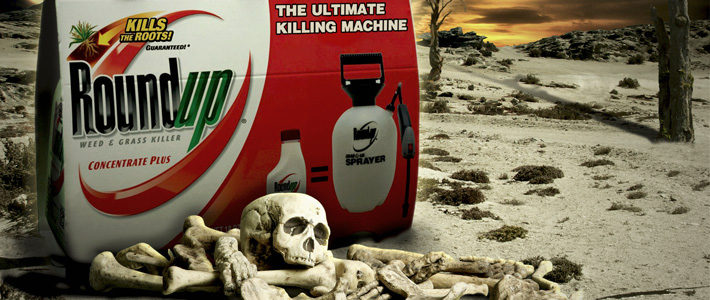 Gardeners Alva and Alberta Pilliod say they used Monsanto’s Roundup spray to keep weeds off their driveway for more than two decades, applying the herbicide while wearing flip flip flops, shorts, and tank tops.. Now, they both have Non-Hodgkin’s Lymphoma (NHL). In a lawsuit, they were awarded $2.05 billion in damages in May.
Gardeners Alva and Alberta Pilliod say they used Monsanto’s Roundup spray to keep weeds off their driveway for more than two decades, applying the herbicide while wearing flip flip flops, shorts, and tank tops.. Now, they both have Non-Hodgkin’s Lymphoma (NHL). In a lawsuit, they were awarded $2.05 billion in damages in May.
School groundskeeper Dewayne Johnson, now in his 40s, also used to spray Roundup up to 30 times every summer. He has the same blood cancer as the Pilliods, and won nearly $80 million in a suit last year.
A third man, Edwin Hardeman, used Roundup for more than 25 years to keep weeds off his oak trees. He got NHL, too. A jury in California ruled in March that Roundup was a “substantial factor” in his diagnosis.
More than 13,000 similar lawsuits have popped up in the US. Almost all are being filed by gardeners, groundskeepers, and other professional weed-whackers who allege that their consistent, repeated use of Roundup gave them cancer.
One of the latest allegations came this week from 44-year-old groundskeeper Jeffrey Sabraski. Sabraski alleges he sprayed Roundup several times per week, wearing nothing but shorts and t-shirts, and has also developed NHL. He’s suing Monsanto, as the Minneapolis Star Tribune reported on Wednesday.
Roundup is the most widely-used herbicide in the world, and its key chemical is called glyphosate. The plaintiffs in this recent surge of court cases say that Monsanto didn’t sufficiently warn them about the potential health risks associated with the product or tell them how to protect themselves from exposure.
But teasing out the health risks of glyphosate isn’t easy. The World Health Organization’s International Agency for Research on Cancer (IARC) says the chemical is “probably” carcinogenic to humans. But the US Environmental Protection Agency (EPA), and the agro-chemical giant Bayer, which now owns Monsanto, both say glyphosate isn’t linked to cancer in any meaningful way.
“EPA continues to find that there are no risks to public health when glyphosate is used in accordance with its current label and that glyphosate is not a carcinogen,” the agency said on its website. Canadian health authorities support the US’ stance.
However, peeling back the curtain on the scientific studies that have looked at glyphosate thus far can tell us a lot about how the chemical can indeed be dangerous when people and animals are exposed to it in the wrong ways.
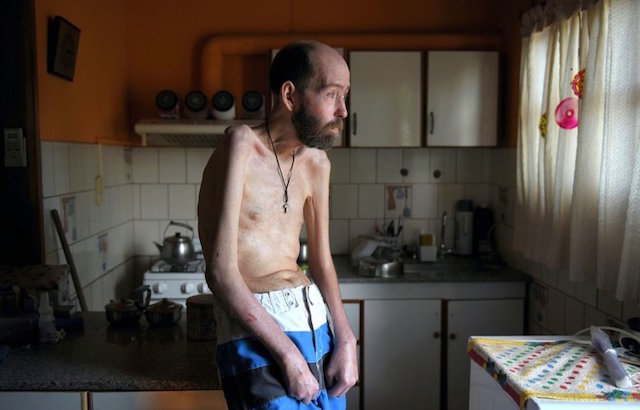
Argentinian former farm worker Fabian Tomasi used to work supplying herbicides for plane-spraying and did not use protection. Pablo Aharonian/AFP/Getty Images
What Monsanto and the EPA say about glyphosate
Glyphosate, which has been in use around the world since the 1970s, blocks an enzyme pathway that helps plants grow. The herbicide’s patent expired in 2000, and Indian and Chinese farmers are now the weed-killer’s biggest buyers.
It’s tricky for epidemiologists to say conclusively that something causes cancer, so what we know so far — from thousands of studies conducted in rats, mice, and humans — is that the pesticide might be linked with cancer, or it might not. Glyphosate might make cancer more likely to sprout up, since there’s evidence it can encourage DNA. But more research is still needed to learn how, exactly, it affects the human body.
Monsanto maintains there’s no good evidence the chemical causes cancer. The company often points to a 2017 study of more than 54,000 pesticide sprayers in Iowa and North Carolina (mostly farmers), which found no statistically significant association between glyphosate and cancer.
The company also often highlights the results of large-scale studies of French, Norwegian, and North American farmers that have found glyphosate to be safe.
But farmers are largely protected from the dangers of herbicides and pesticides, since they spray fields using industrial-grade farm equipment. In that same study, in fact, chemical sprayers who had the most exposure to glyphosate were found to have a slightly higher risk of developing acute myeloid leukemia than people who’d never used the weed-killer. The difference, however, was so small that more research is needed to confirm these results.
The EPA has also consistently said that consumers have nothing to worry about when it comes to glyphosate.
“In 2017, EPA published comprehensive ecological and human health risk assessments for glyphosate. No human health risks were identified,” the agency said in April. However, the EPA cautioned that “potential ecological risks were identified for terrestrial and aquatic plants, birds, and mammals, primarily from exposure to spray drift.”
Humans, of course, are terrestrial mammals, too. And gardeners who use lots of glyphosate — without much protection — would arguably also be exposed to spray drift.
“The evidence is not as strong so as to be absolutely sure” Manolis Kogevinas, of the Barcelona Institute for Global Health, told Business Insider. “But yeah, there’s definitely a chance that they will develop cancer.”
The IARC has a different stance
In March 2015, the IARC convened a group of 17 experts from 11 countries to determine the potential human health dangers of glyphosate, along with four other pesticides and herbicides. The international, non-partisan committee concluded that glyphosate is “probably” carcinogenic to humans, based on studies in humans and lab animals.
 That’s why glyphosate is now a “Group 2A” carcinogen, according to IARC. That means that the chemical is considered to be a contributor to cancer, but not on the level of more well known cancer-causers like formaldehyde and UV radiation.
That’s why glyphosate is now a “Group 2A” carcinogen, according to IARC. That means that the chemical is considered to be a contributor to cancer, but not on the level of more well known cancer-causers like formaldehyde and UV radiation.
But the IARC also has a complicated history with glyphosate research. Reuters reported in 2017 that the agency had cut sections out of a draft report that suggested glyphosate might not contribute to cancer. In a follow-up letter to Congress, IARC director Christopher Wild wrote that the group revised that draft because some of the data came from “a review article co-authored by a Monsanto scientist.”
He added that the information from that article “was insufficient for independent evaluation of the individual studies and the conclusions reached by the Monsanto scientist.”
Why these groups came to different conclusions about glyphosate
A tightly reviewed and vetted paper published in the journal Environmental Sciences Europe earlier this year looked into why the EPA and IARC appear to disagree about the risks of glyphosate. It found that the EPA’s conclusions relied mainly on “unpublished regulatory studies,” many of them industry-funded. The IARC, on the other hand, looked at “mostly peer-reviewed studies.”
That could explain why 99% of the glyphosate studies that the EPA considered found that the chemical is not a cancer-causer, while 70% of the studies the WHO looked at suggested it probably is.
“It’s kind of easy to understand why EPA would say, ‘Well, geez, you know, it must be okay,'” study author Charles Benbrook, an agricultural economist who now serves as an expert witness for plaintiffs involved in Roundup litigation, told Business Insider. “It was okay because they were looking at a bunch of negative studies that Monsanto [did]. Monsanto repeated essentially the same study like 30 times.”
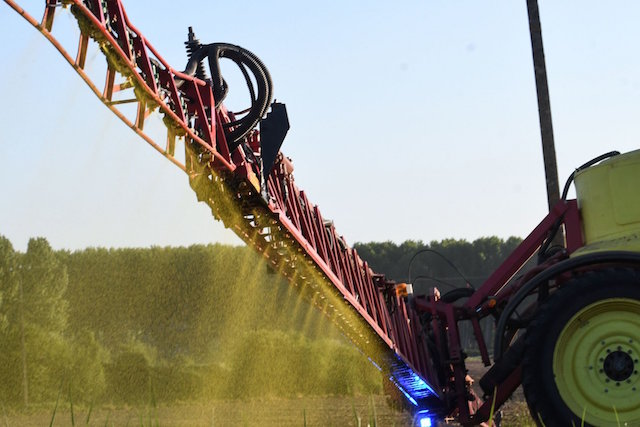
French farmer Nicolas Denieul sprays Roundup 720 glyphosate herbicide produced by Monsanto on May 11, 2018, on a field of corn. Jean-Francois Monier/AFP/Getty Images
Benbrook alleges that the reason so many big payouts are being won in court is that Monsanto didn’t properly warn people who used Roundup at home or on a small scale that they should wear protective clothing when they applied the weed-killer.
“It’s not farmers out in the field with their large, modern spray rigs, where the operator is inside a steel and glass cab with a sophisticated air filtration system that essentially eliminates exposure,” Benbrook said. “Some people are spraying Roundup 6 or 8 hours a day for five days a week with this kind of handheld equipment.”
Monsanto maintains that as long as consumers follow the instructions on the label, glyphosate-based herbicides are perfectly safe. The company also points to hundreds of glyphosate studies in EPA databases that were not Monsanto-funded.
“At the end of the day, whether you’re in the court of law, regulatory agencies, or court of public opinion, it’s the science that should matter here,” a Bayer spokesman said in an email to Business Insider. “And the extensive body of science over 40 years, including several recent human epidemiology studies, shows that glyphosate-based herbicides are not associated with NHL. Customers who know these products best continue to rely on them.”
The company also points to the courtroom testimony of Robert Phalen, an environmental scientist who testified in the Pilliod’s trial that human skin actually repels glyphosate. (Phalen once authored textbook with another scientist also named Robert Phalen, who has said modern air may be “a little too clean.”)
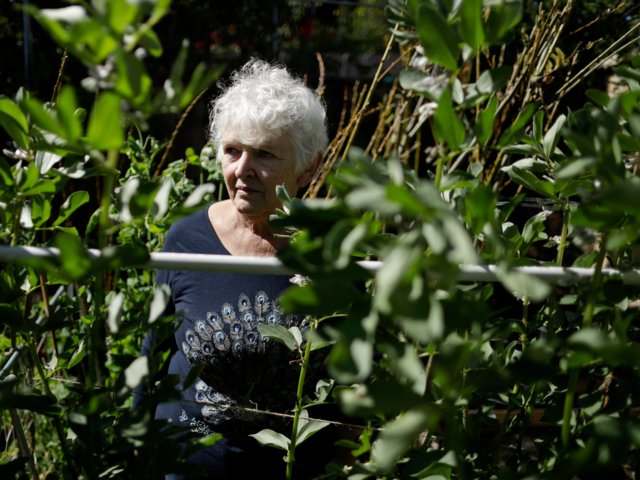
Christine Sheppard in her backyard garden in Oceanside, California. Sheppard said she sprayed Roundup for years to control weeds on her coffee farm in Hawaii. In 2003, she was diagnosed with non-Hodgkin’s lymphoma and given six months to live. Now 68, she is in remission but experiences severe pain in her hands and legs from her cancer treatment and has a weak immune system. AP Photo/Gregory Bull
Monsanto tweaked its Roundup formula in Europe
The US Food and Drug Administration (FDA) recommends that pets stay off lawns and plants that have just been sprayed with glyphosate, since animals can develop digestive or intestinal issues if they touch the substance when it hasn’t dried. Glyphosate has also recently been linked to more severe cases of fatty liver disease in people.
But beyond glyphosate, there’s another compound in Roundup: soap-like detergents called surfactants that help the chemical penetrate the leaves of plants to work its weed-killing magic. Benbrook believes Monsanto should be doing more to warn people about how surfactants work and how to protect themselves.
“It’s the surfactants that are carrying the glyphosate first through the skin and inside the body, and then inside of cells where damage can be done to DNA,” he said.
In Europe, Benbrook noted, surfactant chemicals have been made less toxic for consumers. In the US, however, there’s been less regulatory pressure, so Monsanto has not changed Roundup formulas in the same way.
“When juries learn that Monsanto is making a product that’s at least 10 times, maybe 100 times safer all across Europe?” he said. “That’s not acceptable. That’s one of the reasons that I think we can expect a continuation of these mammoth punitive damage awards that have occurred in the first three trials.”
Bayer said that allegation is one “we don’t believe is supported by the extensive body of science.”
The company told Business Insider in an email that “regulators have specifically assessed the safety of the class of surfactants used in glyphosate-based herbicides; in 2009, the U.S. EPA concluded that these surfactants are not carcinogenic.”
The statement added that Monsanto tweaked the surfactants in products sold in Europe “due to market preferences or country-specific requirements in the region.”
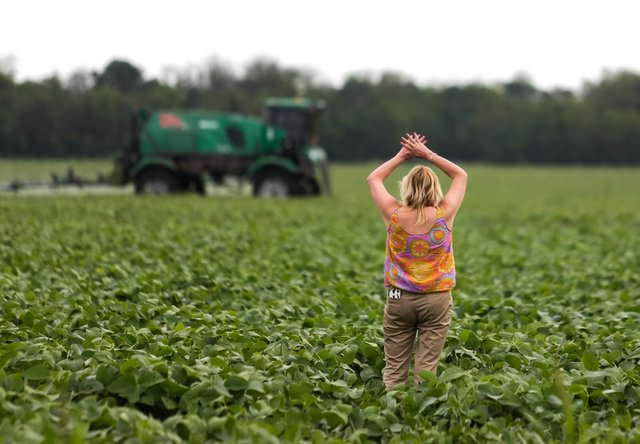
Argentine environmentalist Sofia Gatica tries to stop the spraying at a soybean field in Dique Chico, Argentina, on January 20, 2018. Diego Lima/AFP/Getty Images
Traces of glyphosate in food don’t seem to hurt people
As lawsuits about glyphosate have entered the spotlight, some people have expressed concerns about the trace amounts of the chemical in our food.
The traces of glyphosate found in a bowl of Cheerios or a glass of wine are probably not going to kill anyone, though.
“Using the internationally accepted limits, an average adult male would have to drink over 1,000 liters of wine a day to reach any level of risk,” pharmacologist Ian Musgrave recently wrote in The Conversation.
That said, it’s worth remembering that different people’s bodies can react differently to chemicals. The foods pregnant women eat impact how their fetus grows and develops, for example, and the developing digestive systems of infants and toddlers may be more delicate than others. Scientists are still studying how pesticides can impact childhood brain development.
 Kogevinas still doesn’t think the chemical’s presence in food is much to worry about, though.
Kogevinas still doesn’t think the chemical’s presence in food is much to worry about, though.
“If you ask me, is the glyphosate the problem in my food? No, it is not,” he said. But he noted that he prefers to buy organic produce to avoid pesticides more generally.
Kogevinas lives in Barcelona, where the Roundup formulations adhere to the European standards, but that didn’t affect his decision about whether or not to buy it: He has opted never to use glyphosate in his own garden.
Learn the Truth ~ Additional Reference Reading: Dr. Kelley’s complete tracking of the dangers of the poison, Roundup
Written by Hillary Brueck for Business Insider ~ June 2019
FAIR USE NOTICE: This site contains copyrighted material the use of which has not always been specifically authorized by the copyright owner. We are making such material available in our efforts to advance understanding of environmental, political, human rights, economic, democracy, scientific, and social justice issues, etc. We believe this constitutes a ‘fair use’ of any such copyrighted material as provided for in section 107 of the US Copyright Law. In accordance with Title 17 U. S. C. Section 107, the material on this site is distributed without profit to those who have expressed a prior interest in receiving the included information for research and educational purposes. For more information go to: http://www.law.cornell.edu/uscode/17/107.shtml
